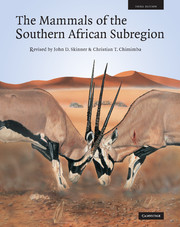Book contents
- Frontmatter
- Contents
- Editorial board
- Acknowledgements
- Foreword
- Preface
- The Mammal Research Institute
- R. H. N. Smithers
- Explanatory notes
- SUPERCOHORT AFROTHERIA
- COHORT PAENUNGULATA
- SUPERCOHORT EUARCHONTAGLIRES COHORT GLIRES
- COHORT EUARCHONTA
- SUPERCOHORT LAURASIATHERIA
- COHORT FERUNGULATA
- Order CARNIVORA
- Order PERISSODACTYLA
- Order SUIFORMES
- Order WHIPPOMORPHA
- Order RUMINANTIA
- Bibliography
- Appendix 1 Conservation status of southern African mammals
- Appendix 2 Colloquial names
- Index of scientific names
- Index of English colloquial names
- List of subscribers
- Plate Section
- Plate Section
- Plate Section
- Plate Section
- Plate Section
- Plate Section
- Plate Section
Order CARNIVORA
from COHORT FERUNGULATA
Published online by Cambridge University Press: 05 July 2013
- Frontmatter
- Contents
- Editorial board
- Acknowledgements
- Foreword
- Preface
- The Mammal Research Institute
- R. H. N. Smithers
- Explanatory notes
- SUPERCOHORT AFROTHERIA
- COHORT PAENUNGULATA
- SUPERCOHORT EUARCHONTAGLIRES COHORT GLIRES
- COHORT EUARCHONTA
- SUPERCOHORT LAURASIATHERIA
- COHORT FERUNGULATA
- Order CARNIVORA
- Order PERISSODACTYLA
- Order SUIFORMES
- Order WHIPPOMORPHA
- Order RUMINANTIA
- Bibliography
- Appendix 1 Conservation status of southern African mammals
- Appendix 2 Colloquial names
- Index of scientific names
- Index of English colloquial names
- List of subscribers
- Plate Section
- Plate Section
- Plate Section
- Plate Section
- Plate Section
- Plate Section
- Plate Section
Summary
THIS ORDER WAS named at a time when it was thought that all the constituent members were flesh eaters, the name being derived from the Latin caro, flesh, and voro, to eat. However, some of the members, such as the African civet (Civettictis civetta) and the side-striped jackal (Canis adustus), have a large vegetarian component in their diet, while others, such as the bat-eared fox (Otocyon megalotis) and the aardwolf (Proteles cristatus), are insectivorous. It is also known that some mammals who are not members of this order eat flesh. Carnivores are, however, all predators to a certain degree.
In the past the Order Carnivora was divided into two suborders: the Fissipedia or terrestrial carnivores, and the Pinnipedia, the marine carnivores. The name Fissipedia is derived from the Latin fissum, to cut, and pes, a foot, indicating that the digits on the feet are independent of one another, and Pinnipedia from the Latin pinna, a feather, and pes, a foot, owing to the superficial resemblance of the flipper to the wing of a bird.
However, there has been some difference of opinion among authorities about whether the Pinnipedia should be considered a suborder of the Order Carnivora or a full order. Neither Pocock (1941) nor Simpson (1945) gave the Pinnipedia ordinal rank, the former in fact regarding them as warranting less than subordinal rank.
- Type
- Chapter
- Information
- The Mammals of the Southern African Sub-region , pp. 358 - 526Publisher: Cambridge University PressPrint publication year: 2005
- 2
- Cited by



